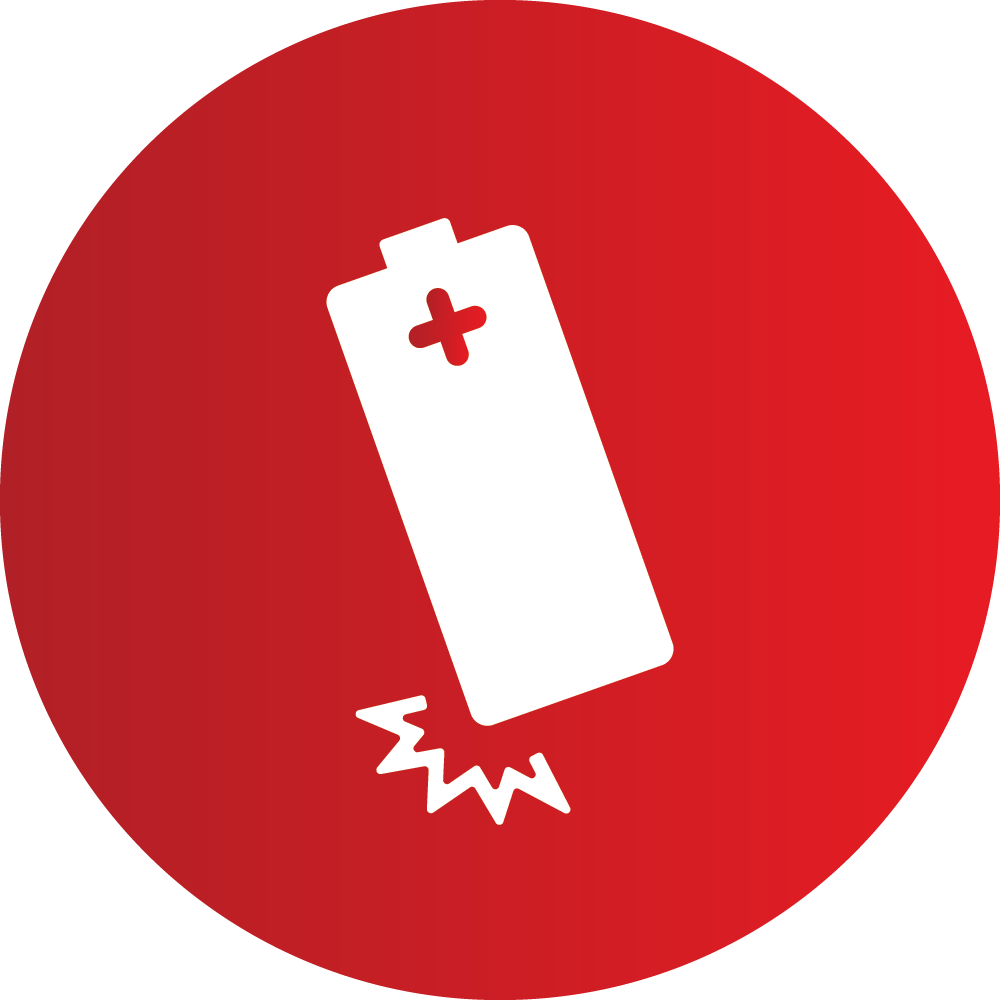Description
Made for Electric Vehicles and E-bikes. Slim and powerful design, easily mountable power.
Battery Spec's
Rated Capacity: 10.8Ah, 553Wh
Nominal Voltage: 51.2 Vdc
Cycle Life: 2000 @ 0.2C (100% DOD), 6000 @ 0.2C (80% DOD), 10000 @ 0.2C (50% DOD)
Dimensions: L 254 × W 106 × H 169mm (10 x 4.17 x 6.65”)
Weight: 4.8kg (10.58lbs)
Battery Management System: Short Circuit, Current, Voltage, Cell Balancing
Cells: 26650 3.6Ah LiFePO4, 16S3P
Charging Method: Constant Current - Constant Voltage (CC - CV): (0.2C to 57.6Vdc) - (57.6Vdc to 0.01C)
Voltage Limits: Charge: 58.4Vdc, Discharge: 40Vdc
Current Limits: Charge: 10.8Adc, Discharge: 60Adc
Temperature Limits: Charge 0 ~ 45°C, Discharge -20 ~ 55°C, Storage -20 ~ 55°C
Connectivity: Series: N/A, Parallel: Unlimited* (51.2Vdc)
Terminal Connector: 14AWG Wire Lead (300mm)/ Anderson PP45 Connector
Ingress Protection: IP65
Battery Features

WaterProof
Battery was designed to withstand splash damage and/or brief water submersion.

FeatherWeight
Battery offers half the weight of its lead-acid counterpart.

Shock Resistant
Battery is vibration tested and designed with solid casing to help withstand shock damage.
What is Rocket Pack ?
Supercharged BMS ensure you get maximum juice out of our battery cells. Up to 3C! Designed to handle Electric Motor surges and deliver the Horsepower and Torque you need to drive!
Warranty
If each Lynac Lithium Technology battery product does not sufficiently meet the outlined performance specifications, a full refund is to be given once the product is returned, inspected, and proven faulty.
Seller assumes a 3-year manufacturer's warranty followed by a 4 year prorated warranty totalling 7 years.
Each product must be registered and proven to be used and maintained according to the recommended operational and maintenance parameters that are to be agreed upon at the time of installation.
To register a product Click Here
UN 38.3 Certification
Did you know the U.S. Department of Transportation and many international regulatory bodies require lithium batteries are certified to UN38.3 prior to transport?
Shipping Standards For Lithium Batteries
Lithium batteries must have safeguards built in to withstand the physical and environmental hazards encountered not only during shipping but throughout their lifetimes. UN38.3 is the prevailing United Nations standard that lithium batteries must meet to receive certification for safe transport. The U.S. Department of Transportation and many international regulatory bodies require lithium batteries are certified to UN38.3 prior to transport.
Lithium batteries must undergo a rigorous series of tests to meet UN38.3 performed by an approved independent testing laboratory. Batteries must not rupture, leak, disassemble, or catch fire to receive certification. There are eight tests that that must be passed for a lithium battery to receive the certification.
Testing For UN38.3 Certification
- Altitude Simulation, which means that low-pressure testing simulates unpressurized airplane cargo space at 15,000 meters.
- Thermal Testing, ensures the cell and battery remain sealed through rapid and extreme temperature changes.
- Vibration Testing meaning it simulates vibration during transport, followed by Shock which assesses cells and battery's ability to withstand cumulative physical shock.
- External Short Circuit, which assesses a battery's ability to withstand prolonged external short circuit conditions.
- Impact & Crush. This simulates a battery's ability to withstand mechanical abuse that could create an internal short circuit.
- Overcharge aka evaluating the battery's ability to withstand overcharge conditions, and finally, Forced Discharge, which tests the battery's ability to withstand its stated maximum discharge rating.
The responsibility to ensure that batteries meet the UN standard falls upon the seller and unfortunately, some products in the marketplace do not meet the standard. UN38.3 is an extremely important safeguard for you the customer. A lithium battery could see a 15 year or longer lifetime depending on how often it is discharged and UN38.3 certification should be a primary consideration in your lithium battery purchase.
FAQ
Check out our FAQ to get answers to common LFP questions!
Goto FAQ Page
The Lynac Advantage
Certified Grade A Cells
The highest grade cells give our LFP batteries the quality and performance that you would expect from your LFP battery leader.
Oversized BMS
Oversized Battery Management System (BMS) puts our LFP batteries above and beyond the standard, producing peak power output at maximum efficiency will ensure the highest performance and longest cycle life.
Designed in North America
Lynac Lithium is based in North America where we push the limits of battery innovation by designing and building quality products with your feedback!
Lynac Intel Plus App
Download our Lynac Intel Plus App to take full advantage of your battery!
This is the most powerful Bluetooth App with Extensive Monitoring Features, Adjustable Parameters, and a Remote Kill-Switch for Charging and Discharging.
For more information about our app check out our blog: https://www.lynac.com/lynac-intel-plus-app-review/
Have more questions? Get in touch with us and we will answer you ASAP!

















